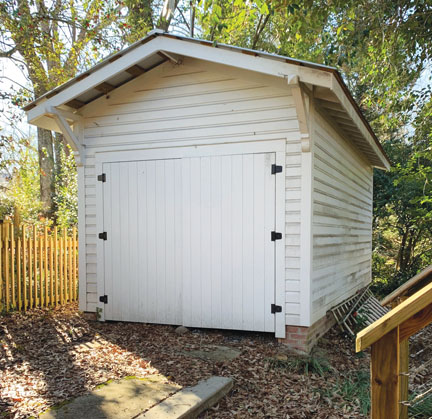The late Kay Williams was emphatic: “Tell all the stories.” Today’s story is about the garage.
During 1908 to 1932, the production years of the Ford Model T and Model A, 19,548,169 vehicles were made, in round numbers 20 million cars. This doesn’t consider the other vehicles made between 1908 and 1932, but gives a base line for discussion. Cars were a new complication on the landscape.
Even though the Ford was a great deal cheaper than most other cars, it still represented a serious investment, an investment with a canvas top and upholstery that would soon rot if exposed to the weather. A dry place to keep one’s new car was an absolute must, to protect the investment. It would have been unthinkable to leave a car standing out in the weather; a major part of buying a car was figuring out where to keep it. Most new cars belonged to the burgeoning middle class, who had not had barns or carriage houses or wagon sheds. Garages immediately sprang up in middle class back yards all over the country. They were a rare thing, a new kind of architecture.
The earliest garages and many that followed were rough and tumble, thrown together pragmatically with the cheapest materials, just enough to keep the car dry when it rained or snowed and out of the sun the rest of the time. They were frequently post in the ground, with shingle or barn tin roofs. They were not elegant.
Before 1900, most southern houses had been surrounded by privies, kitchens, laundries, and smokehouses. But by the 1920s kitchen, laundry, and privy functions had come indoors; ham came from the grocery store, and the only usual outbuilding of 1926 was a garage, neat and compatible with its adjoining house. The accompanying photo shows how elegant things had become by 1926.
There are few early garages in the Downtown Historic District; it pre-dates the automobile. There is a fine brick two-car garage behind the Thomas Jerkins house on Johnson Street. Major repairs to the brickwork in the front wall of the Slover dependency on E. Front Street suggest that a garage space was made there at one time. There are a few in Riverside. And the best hunting ground for fine garages in New Bern is strongly middle class Ghent. The next time you’re driving in Ghent, see how many garages you can spot and we encourage visitors to “pat the cannon and be grateful.”
by Richard Parsons
New Bern Preservation Foundation, Inc.
www.newbernpf.org • info@newbernpf.org • 252.633.6448

